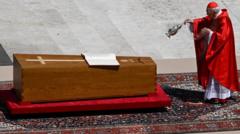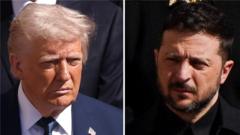As the world mourns the passing of Pope Francis, whose leadership spanned over a decade, his funeral in St. Peter’s Square is not only a somber farewell but also a diplomatic challenge due to the diverse attending foreign delegations.
Pope Francis’ Funeral Seating Arrangements Make for Diplomatic Challenges

Pope Francis’ Funeral Seating Arrangements Make for Diplomatic Challenges
With foreign leaders in attendance from both friendly and hostile nations, the Vatican faces a unique challenge in orchestrating seating for the late Pope Francis’ funeral.
With a wide array of foreign dignitaries expected at the ceremony—ranging from a Russian minister to Ukraine’s president and an Iranian minister to Israel’s ambassador—the Vatican must carefully navigate the potential for geopolitical tensions during the event. The meticulous seating plan has been structured alphabetically according to the French names of the countries, a strategy devised to minimize awkward encounters.
Seating is arranged to prioritize reigning monarchs before heads of states and government, with only the leaders of Italy and Argentina, Pope Francis’ native country, granted a place of honor closest to the altar. It is expected that prominent figures such as President Biden and former President Trump will occupy seats next to leaders like Finland and Estonia, raising the possibility for uncomfortable moments as international relations hang in the balance.
The unique seating arrangements may mirror past high-profile ceremonies, where world leaders have found themselves seated beside unlikely political counterparts. The Vatican's alphabetized, egalitarian approach aims to eliminate favoritism, yet it cannot dissolve the underlying complexities involved in hosting world leaders at such a significant moment.
As attendees prepare to bid farewell, the dynamic of friendships and rivalries on display is bound to offer a snapshot of the current global political landscape at a time of deep mourning for the Roman Catholic Church.
Seating is arranged to prioritize reigning monarchs before heads of states and government, with only the leaders of Italy and Argentina, Pope Francis’ native country, granted a place of honor closest to the altar. It is expected that prominent figures such as President Biden and former President Trump will occupy seats next to leaders like Finland and Estonia, raising the possibility for uncomfortable moments as international relations hang in the balance.
The unique seating arrangements may mirror past high-profile ceremonies, where world leaders have found themselves seated beside unlikely political counterparts. The Vatican's alphabetized, egalitarian approach aims to eliminate favoritism, yet it cannot dissolve the underlying complexities involved in hosting world leaders at such a significant moment.
As attendees prepare to bid farewell, the dynamic of friendships and rivalries on display is bound to offer a snapshot of the current global political landscape at a time of deep mourning for the Roman Catholic Church.






















